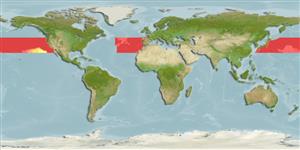>
Argentiniformes (Marine smelts) >
Opisthoproctidae (Barreleyes or spookfishes)
Etymology: Dolichopteryx: Greek, dolichos = long + Greek, pteryx, = wing, fin (Ref. 45335); longipes: longipes refers to the long pelvics (Ref. 4525).
More on author: Vaillant.
Environment: milieu / climate zone / depth range / distribution range
Ökologie
seewasser bathypelagisch; ozeanodrom (Ref. 51243); tiefenbereich 500 - 2400 m (Ref. 74511). Deep-water; 45°N - 27°N, 180°W - 180°E
Probably worldwide in temperate and tropical waters. Eastern Pacific: California Current region (Ref. 35626). South China Sea (Ref.74511).
Size / Gewicht / Alter
Maturity: Lm ? range ? - ? cm
Max length : 18.0 cm SL Männchen/unbestimmt; (Ref. 6542)
Kurzbeschreibung
Morphologie | Morphometrie
Rückenflossenweichstrahlen (insgesamt): 10-11; Afterflossenweichstrahlen: 8 - 9; Wirbelzahl: 46 - 47. Body deep. Short pectoral fins, long ventral fins. Relatively large head and absence of ventral light organs. Line of dark chromatophores along the body below lateral line (Ref. 37473).
Oceanic and mesopelagic species (Ref. 6686). Taken regularly at depths shallower than 458 m, with scientific deep-sea fishing gear. Feed mainly on small crustaceans, particularly copepods (Ref. 4525). Oviparous, with planktonic larvae (Ref. 35626) and eggs (Ref. 6686). Paedomorphic (Ref. 35626).
Life cycle and mating behavior
Geschlechtsreife | Fortpflanzung | Ablaichen | Eier | Fecundity | Larven
Quéro, J.-C., 1990. Opisthroproctidae. p. 241-243. In J.C. Quero, J.C. Hureau, C. Karrer, A. Post and L. Saldanha (eds.) Check-list of the fishes of the eastern tropical Atlantic (CLOFETA). JNICT, Lisbon; SEI, Paris; and UNESCO, Paris. Vol. 1. (Ref. 6542)
IUCN Rote Liste Status (Ref. 130435)
Bedrohung für Menschen
Harmless
Nutzung durch Menschen
Mehr Information
ReferenzenAquakulturAquakultur ProfilZuchtlinienGenetikElectrophoresesVererbbarkeitKrankheitenVerarbeitungNutrientsMass conversion
PartnerBilderStamps, Coins Misc.LauteCiguateraGeschwindigkeitSchwimmstilKiemenoberflächeOtolithsGehirngrößeSehfähigkeit
Tools
Zusatzinformationen
Download XML
Internet Quellen
Estimates based on models
Preferred temperature (Ref.
123201): 3 - 5, mean 4.1 °C (based on 66 cells).
Phylogenetic diversity index (Ref.
82804): PD
50 = 0.5020 [Uniqueness, from 0.5 = low to 2.0 = high].
Bayesian length-weight: a=0.00437 (0.00170 - 0.01121), b=3.10 (2.88 - 3.32), in cm total length, based on LWR estimates for this (Sub)family-body shape (Ref.
93245).
Trophic level (Ref.
69278): 3.0 ±0.00 se; based on food items.
Generation time: 2.2 ( na - na) years. Estimated as median ln(3)/K based on 1
growth studies.
Widerstandsfähigkeit (Ref.
120179): mittel, Verdopplung der Population dauert 1,4 - 4,4 Jahre. (Assuming tmax>3).
Fishing Vulnerability (Ref.
59153): Low to moderate vulnerability (25 of 100).
